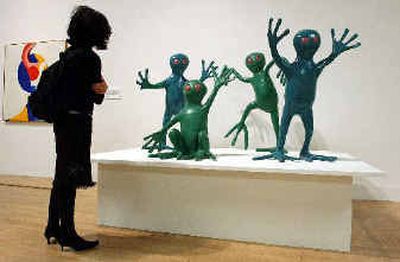Welcome to the 60s

Smiling green Martians appear to dance atop a white platform, their slender hands stretching upward. Nearby, soap bubbles spill from a tall plastic tube and flow slowly into a basin.
Welcome back to the 1960s — the era of breaking rules, pushing boundaries and making art of subjects strange and mundane.
The Tate Britain museum in London is taking a fresh look at British painting, sculpture and photography from the often-mythologized decade in a show called “Art & the 60s: This Was Tomorrow.”
With the 1960s aesthetic continuing to exert a powerful influence on contemporary artists, the museum thought it was a good time to take another look, said co-curator Chris Stephens.
The show includes pieces by such painters as David Hockney as well as works by lesser-known artists, and it focuses on movements that have been forgotten in ensuing decades but played a major role in Britain’s ‘60s culture.
The country was just emerging from the grim years of post-World War II rationing and rebuilding. London was envied around the world as the vibrant center for swinging, hip youth — home to the Beatles, the Rolling Stones and model Twiggy, one of the decade’s most famous faces.
“The art was unusually integrated into more mainstream culture,” Stephens said. “The artists were part of a larger scene of pop stars and actors … and designers.”
As the 1950s ended, he said, “It genuinely seemed like Britain was coming out of a miserable period into one of greater wealth and comfort. Life was just going to be better and freer. That kind of belief that you can do anything and change anything is in the work … the scale and color of freshness of it.”
Such optimism is evident in Nicholas Monro’s 1965 piece, “Martians” — four kindly looking, green plastic creatures, each a few feet high, with skinny limbs and oddly splayed fingers and toes. Monro’s vision of benevolent aliens clearly reflects the decade’s futuristic fascination with space travel and science fiction.
David Medalla’s “Cloud Canyons No. 3,” the piece whose bubbles percolate through a clear plastic tube, is more down-to-earth but just as eccentric, the low hum of its electric compressor producing a soothing background sound.
The exhibit gives some space to the genre many people most associate with the 1960s, the Pop Art movement pioneered by such artists as Andy Warhol.
A 1961 painting by Derek Boshier puts booster rockets on Special K cereal’s logo, the large red “K” flying skyward with plumes of flame trailing behind. David Hockney’s 1961 “Tea Painting in an Illusionistic Style” depicts a huge, red box of Typhoo, a beloved British tea brand, which the artist said was a favorite of his mother.
But Stephens said it was important to make the show about more than just Pop, and to highlight the many links between artists traditionally boxed off into distinct categories or schools of thought.
Abstract art is well-represented. The 1960 “Film Star” defies categorization, with dozens of books and pieces of books bound by their spines to a canvas, the pages flapping open at all angles.
Photography is also a major component of the show, which includes dozens of images of some of the decade’s most famous faces.
A montage of 12 photos of Twiggy were taken by Ronald Traeger, the photographer who helped make her a fashion icon. David Bailey’s “Box of Pinups” is a collection of 36 photos of stars that include John Lennon, Paul McCartney, Michael Caine, Rudolf Nureyev and Mick Jagger.
Jagger makes another appearance in the show with art dealer Robert Fraser as the two are hauled off to jail in handcuffs after a drug bust. Richard Hamilton made a painted collage based on a tabloid photograph of the two, who shield their faces.